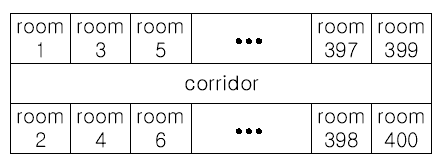Moving Tables
Time Limit : 2000/1000ms (Java/Other) Memory Limit : 65536/32768K (Java/Other)
Total Submission(s) : 9 Accepted Submission(s) : 1
Font: Times New Roman | Verdana | Georgia
Font Size: ← →
Problem Description

The floor has 200 rooms each on the north side and south side along the corridor. Recently the Company made a plan to reform its system. The reform includes moving a lot of tables between rooms. Because the corridor is narrow and all the tables are big, only
one table can pass through the corridor. Some plan is needed to make the moving efficient. The manager figured out the following plan: Moving a table from a room to another room can be done within 10 minutes. When moving a table from room i to room j, the
part of the corridor between the front of room i and the front of room j is used. So, during each 10 minutes, several moving between two rooms not sharing the same part of the corridor will be done simultaneously. To make it clear the manager illustrated the
possible cases and impossible cases of simultaneous moving.

For each room, at most one table will be either moved in or moved out. Now, the manager seeks out a method to minimize the time to move all the tables. Your job is to write a program to solve the manager’s problem.
Input
two positive integers s and t, representing that a table is to move from room number s to room number t (each room number appears at most once in the N lines). From the N+3-rd line, the remaining test cases are listed in the same manner as above.
Output
Sample Input
3 4 10 20 30 40 50 60 70 80 2 1 3 2 200 3 10 100 20 80 30 50
Sample Output
10 20 30
/*
解题思路,找出每组测试数据中,经过每个房间的次数,
则桌子经过最多的那个房间的次数乘以10就等于移动桌子
所需要最短的时间。
*/
#include<stdio.h>
#include<string.h>
#include<stdlib.h>
#include<algorithm>
using namespace std;
int cmp(int a,int b)
{
return a>b;
}
int main()
{
int T,n,i,j,s,t,c,a[450];
scanf("%d",&T);
while(T--)
{
memset(a,0,sizeof(a));/*将数组所有数初始化为零,
即将所有房间被经过的次数初始化为零*/
scanf("%d",&n);
for(i=0;i<n;i++)
{
scanf("%d%d",&s,&t);
if(s>t)/*无论开始的房间号大还是目的地房间号大,都可以
看做从号码小的房间出发*/
{
c=s;
s=t;
t=c;
}
if(s%2==0)//考虑实际情况出发房间号为偶数时,求经过房间时应减一
s=s-1;
if(t&1)//目的地房间号为奇数时应加一
t=t+1;
for(j=s;j<=t;j++)
a[j]++;
}
sort(a,a+450,cmp);
printf("%d\n",a[0]*10);
}
return 0;
}